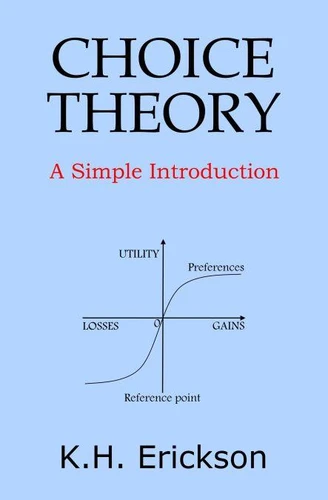Choice Theory: A Simple Introduction. Simple Introductions, #2
Par :Formats :
Disponible dans votre compte client Decitre ou Furet du Nord dès validation de votre commande. Le format ePub est :
- Compatible avec une lecture sur My Vivlio (smartphone, tablette, ordinateur)
- Compatible avec une lecture sur liseuses Vivlio
- Pour les liseuses autres que Vivlio, vous devez utiliser le logiciel Adobe Digital Edition. Non compatible avec la lecture sur les liseuses Kindle, Remarkable et Sony
 , qui est-ce ?
, qui est-ce ?Notre partenaire de plateforme de lecture numérique où vous retrouverez l'ensemble de vos ebooks gratuitement
Pour en savoir plus sur nos ebooks, consultez notre aide en ligne ici
- FormatePub
- ISBN978-1-301-87853-6
- EAN9781301878536
- Date de parution03/10/2013
- Protection num.pas de protection
- Infos supplémentairesepub
- ÉditeurBluewater
Résumé
Choice Theory: A Simple Introduction offers an accessible guide to the central theories and methods of choice theory, with examples and calculations, empirical evidence, and over 20 diagrams to support the analysis. Examine expected value theory, with the two envelopes problem and St. Petersburg paradox which challenge it. Understand expected utility theory and learn how to create a utility function, and assess the Ellsberg paradox, Allais paradox, and preference reversal phenomenon.
Look at risk neutral, risk seeking and risk averse attitudes, explore original, cumulative and third generation prospect theory, and the role of risk sensitivity and loss aversion. Evaluate zero-sum games, minimax and maximin strategies, and see how a mixed minimax strategy can overcome game outcome cycles. Understand auction theory, with the revenue equivalence theorem for English, Dutch, and sealed bid private value auctions, and how bidders may avoid the winner's curse in common value auctions.
Examine voting theory, with voter preferences, the median voter theorem, Condorcet winner, and Condorcet voting cycles. See how voters or government can manipulate the voting system.
Look at risk neutral, risk seeking and risk averse attitudes, explore original, cumulative and third generation prospect theory, and the role of risk sensitivity and loss aversion. Evaluate zero-sum games, minimax and maximin strategies, and see how a mixed minimax strategy can overcome game outcome cycles. Understand auction theory, with the revenue equivalence theorem for English, Dutch, and sealed bid private value auctions, and how bidders may avoid the winner's curse in common value auctions.
Examine voting theory, with voter preferences, the median voter theorem, Condorcet winner, and Condorcet voting cycles. See how voters or government can manipulate the voting system.
Choice Theory: A Simple Introduction offers an accessible guide to the central theories and methods of choice theory, with examples and calculations, empirical evidence, and over 20 diagrams to support the analysis. Examine expected value theory, with the two envelopes problem and St. Petersburg paradox which challenge it. Understand expected utility theory and learn how to create a utility function, and assess the Ellsberg paradox, Allais paradox, and preference reversal phenomenon.
Look at risk neutral, risk seeking and risk averse attitudes, explore original, cumulative and third generation prospect theory, and the role of risk sensitivity and loss aversion. Evaluate zero-sum games, minimax and maximin strategies, and see how a mixed minimax strategy can overcome game outcome cycles. Understand auction theory, with the revenue equivalence theorem for English, Dutch, and sealed bid private value auctions, and how bidders may avoid the winner's curse in common value auctions.
Examine voting theory, with voter preferences, the median voter theorem, Condorcet winner, and Condorcet voting cycles. See how voters or government can manipulate the voting system.
Look at risk neutral, risk seeking and risk averse attitudes, explore original, cumulative and third generation prospect theory, and the role of risk sensitivity and loss aversion. Evaluate zero-sum games, minimax and maximin strategies, and see how a mixed minimax strategy can overcome game outcome cycles. Understand auction theory, with the revenue equivalence theorem for English, Dutch, and sealed bid private value auctions, and how bidders may avoid the winner's curse in common value auctions.
Examine voting theory, with voter preferences, the median voter theorem, Condorcet winner, and Condorcet voting cycles. See how voters or government can manipulate the voting system.






















